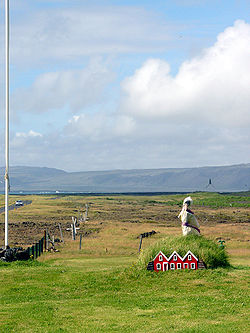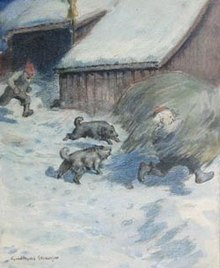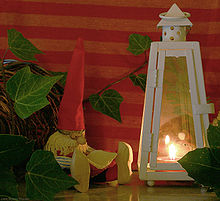Týr is a god associated with law and heroic glory in Norse mythology, portrayed as one-handed. Corresponding names in other Germanic languages are Gothic Teiws, Old English Tīw and Old High German Ziu and Cyo, all from Proto-Germanic *Tîwaz (*Tē₂waz). The Latinised name is Tius or Tio. In the late Icelandic Eddas, Tyr is portrayed, alternately, as the son of Odin (Prose Edda) or of Hymir (Poetic Edda)
Tiw was equated with Mars in the interpretatio germanica. Tuesday is in fact "Tīw's Day" (also in Alemannic Zischtig from zîes tag), translating dies Martis.
Name
Old Norse Týr, literally "god", plural tívar "gods", comes from Proto-Germanic *Tē₂waz (cf. Old English Tīw, Old High German Zīo), which continues Proto-Indo-European *deiwós "celestial being, god" (cf. Welsh duw, Latin deus, Lithuanian diẽvas, Sanskrit dēvá, Avestan daēvō "demon").The earliest attestation for Týr's continental counterpart occurs in Gothic tyz "the t-rune" (𐍄) in the 9th-century Codex Vindobonensis 795. The name is later attested in Old High German as Cyo in the A Wessobrunn prayer ms. of 814. The Negau helmet inscription (2nd century b.c.) may actually record the earliest form, teiva, but this interpretation is tentative.
Týr in origin was a generic noun meaning "god", e.g. Hangatyr, literally, the "god of the hanged", as one of Odin's names, which was probably inherited from Tyr in his role as god of justice. The name continues on as Norwegian Ty, Swedish Tyr, Danish Tyr, while it remains Týr in Modern Icelandic and Faroese.
West Germanic Ziu/Tiw/Tiwaz
A gloss to the Wessobrunn prayer names the Alamanni Cyowari (worshipers of Cyo) and their capital Augsburg Ciesburc.The Excerptum ex Gallica Historia of Ursberg (ca. 1135) records a dea Ciza as the patron goddess of Augsburg. According to this account, Cisaria was founded by Swabian tribes as a defence against Roman incursions. This Zisa would be the female consort of Ziu, as Dione was of Zeus.
The name of Mars Thingsus (Thincsus) is found in an inscription on an 3rd century altar from the Roman fort and settlement of Vercovicium at Housesteads in Northumberland, thought to have been erected by Frisian mercenaries stationed at Hadrian's Wall. It is interpreted as "Mars of the Thing". Here is also worth noting what Tacitus stated in his work Germania about capital punishment amongst the Germanic folk; that none could be flogged, imprisoned or executed, not even on order of the warlord, without the consent of the priest; who was himself required to render his judgement in accordance with the will of the god they believe accompanies them to the field of battle In the same source this god is stated being the chief deity.
Tacitus also named the German "Mars" as the primary deity, along with the German "Mercury", associated with the Germanic custom of the disposal of the spoils of war; as practiced from the 4th century BC to the 6th century AD.
In the Old English Rune Poem, the rune that is otherwise named for Tiw in the other rune poems (Abecedarium Nordmanicum, Old Norwegian Rune Rhyme, Old Icelandic Rune Poem), is called tir, meaning "glory". This rune was inscribed on more Anglo-Saxon cremation urns than any other symbol.
North Germanic Tyr
An early depiction of Tyr is found on the IK 190 bracteate found near Trollhättan, Sweden. The figure is shown with long hair, holding a sceptre in his left hand, and with a wolf biting his right.According to the Poetic Edda and Prose Edda, at one stage the gods decided to shackle the Fenris wolf (Fenrir), but the beast broke every chain they put upon him. Eventually they had the dwarves make them a magical ribbon called Gleipnir. It appeared to be only a silken ribbon but was made of six wondrous ingredients: the sound of a cat's footfall, the beard of a woman, the roots of a mountain, bear's sinews, fish's breath and bird's spittle. The creation of Gleipnir is said to be the reason why none of the above exist. Fenrir sensed the gods' deceit and refused to be bound with it unless one of them put his hand in the wolf's mouth.
Tyr, known for his great wisdom and courage, agreed, and the other gods bound the wolf. After Fenrir had been bound by the gods, he struggled to try to break the rope. Fenrir could not break the ribbon and enraged, bit Tyr's right hand off. When the gods saw that Fenrir was bound they all rejoiced, except Tyr. Fenrir will remain bound until the day of Ragnarök. As a result of this deed, Tyr is called the "Leavings of the Wolf"; which is to be understood as a poetic kenning for glory. After a heartbreaking battle (of Ragnarök) Fenrir swallowed Odin the All-father, whole.
According to the Prose version of Ragnarok, Tyr is destined to kill and be killed by Garm, the guard dog of Hel. However, in the two poetic versions of Ragnarok, he goes unmentioned; unless one believes that he is the "Mighty One".
In Lokasenna, Tyr is taunted with cuckoldry by Loki, maybe another hint that he had a consort or wife at one time.
In the Hymskvidha, Tyr's father is named as the etin Hymir – the term "Hymir's kin" was used a kenning for etinkind – while his mother goes unnamed, but is otherwise described in terms that befit a goddess. This myth also pairs Tyr with Thor, and draws a comparison between their strength via the lifting of Hymir's cauldron. Thor proves the stronger, but other than Thor's own son, Magni, Tyr is the only deity whose strength is ever questioned in comparison to the Thunderer's.
Tiwaz rune
The t-rune ᛏ is named after Tyr, and was identified with this god; the reconstructed Proto-Germanic name is *Tîwaz. The rune is sometimes also referred to as *Teiwaz, or spelling variants.Rune poems
Tiwaz is mentioned in all three rune poems. In the Icelandic and Norwegian poems, the rune is associated with the god Tyr.| stanza | translation | comments |
| Old Norwegian ᛏ Tyr es einhendr Asa; opt verðr smiðr at blasa. |
Tyr is the one-handed god; often happens the smith must blow. |
|
| Old Icelandic ᛏ Týr er einhendr áss ok ulfs leifar ok hofa hilmir. Mars tiggi. |
Tyr is a one-handed god, and leavings of the wolf and prince of temples. |
the "Mars tiggi" is a gloss and not part of the poem itself, indicating that Týr was associated with the Roman deity and/or the planet Mars. |
| Old English ᛏ [tir] biþ tacna sum, healdeð trywa wel wiþ æþelingas; a biþ on færylde ofer nihta genipu, næfre swiceþ. |
[Fame] is a sign, it keeps faith well with athelings, it is always on its course over the mists of night, it never fails. |
The tir "fame, honour" is a gloss written alongside the rune. Several interpretations have been offered, typically involving association with the north star, as the words tacna and færyld have astronomical connotations (used for "sign of the zodiac" and "path of a planet", respectively). |
Usage
Ancient usage
Multiple Tiwaz runes
Multiple Tiwaz runes either stacked atop one another to resemble a tree-like shape, or repeated after one another, appear several times in Germanic paganism:-
- The charm (alu) on the Lindholm amulet, dated from the 2nd to the 4th century contains three consecutive t runes, has been interpreted as an invocation of Tyr.
- The Kylver Stone (400 AD, Gotland) features 8 stacked Tiwaz runes at the end of an Elder Futhark inscription.
- From 500 AD, a Scandinavian C-bracteate (Seeland-II-C) features an Elder Futhark inscription ending with three stacked Tiwaz runes.
Poetic Edda
According to the runologist Lars Magnar Enoksen, the Tiwaz rune is referred to in a stanza in Sigrdrífumál, a poem in the Poetic Edda.Sigrdrífumál tells that Sigurd has slain the dragon Fafnir and arrives at a fortress of shields on top of a mountain which is lit by great fires. In the fortress, he finds an enchanted sleeping Valkyrie whom he wakes by cutting open her corslet with his sword. The grateful Valkyrie Sigrdrífa offers him the secrets of the runes in return for delivering her from the sleep, on condition that he shows that he has no fear. The Valkyrie begins by teaching him that if he wants to achieve victory in battle, he is to carve "victory runes" on his sword and twice say the name "Týr" - the name of the Tiwaz rune.
|
|
Lexical traces
In the sphere of organized warfare, Tyr/Tiw had become relatively unimportant compared to Odin/Woden in both North and West Germanic by the close of the Migration Age. Traces of the god remain, however, in Tuesday (Old English tíwesdæg "Tiw's day"; Old Frisian tîesdei, Old High German zîestag, Alemannic and Swabian dialect in south west Germany (today) Zieschdig/Zeischdig, Old Norse týsdagr), named after Tyr in both the North and the West Germanic languages (corresponding to Martis dies, dedicated to the Roman god of war and the father-god of Rome, Mars) and also in the names of some plants: Old Norse Týsfiola (after the Latin Viola Martis), Týrhialm (Aconitum, one of the most poisonous plants in Europe whose helmet-like shape might suggest a warlike connection) and Týviðr, "Tý's wood", Tiveden may also be named after Tyr, or reflecting Tyr as a generic word for "god" (i.e., the forest of the gods). In Norway the parish and municipality of Tysnes are named after the god.German Dienstag and Dutch dinsdag (Tuesday) might be derived from Mars Thingsus, as mentioned above.








